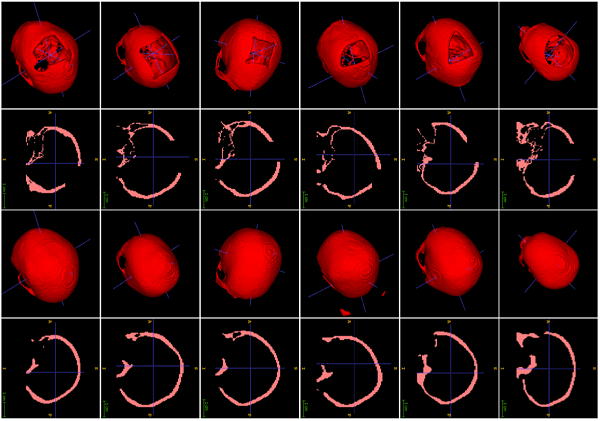Improving the model generalization ability for cranial implant design
Cranial defects from brain tumor surgery or head trauma can come with different size, shape and position. Besides being able to generalize across various skulls (patients), a deep learning model must also generalize well to various defect patterns, which is however a challenging task when it comes to high-resolution skulls (Downsampling the skulls to lower resolutions can mitigate the generalization problem [1] Appendix A & B, which is nonetheless not encouraged as downsampling can result in loss of image quality and subsequently coarse output). In order to improve the generalization ability on the original high-resolution data (512 x 512 xZ), there are primarily two ways proven to be effective:
- To augment the dataset by creating various defect patterns for traininig [2].
- To use a shape prior of the complete skull [3], [4].
The rationale behind using data agumentation is straightforward - to create a similar distribution of the defects (shape, size, position) in the test set compared to the training set. Using shape prior to increase the model robustness bears more algorithmic elegance and is encouraged (not mandatory though. Participants could use other approaches as long as they work well) in this task. Could a deep learning model trained (only) on skulls with similar defect patterns generalize to randomly shaped, sized and positioned defects in the test set with the help of a shapr prior?
** Task 3 related inquiries: autoimplant.challenge@gmail.com
- [1] Li, J., Pepe, A., Gsaxner, C., von Campe, G. and Egger, J., 2020. A Baseline Approach for AutoImplant: the MICCAI 2020 Cranial Implant Design Challenge. arXiv preprint arXiv:2006.12449.
- [2] Ellis, D.G. and Aizenberg, M.R., 2020, October. Deep Learning Using Augmentation via Registration: 1st Place Solution to the AutoImplant 2020 Challenge. In Towards the Automatization of Cranial Implant Design in Cranioplasty (pp. 47-55). Springer, Cham.
- [3] Matzkin, F., Newcombe, V., Glocker, B. and Ferrante, E., 2020, October. Cranial Implant Design via Virtual Craniectomy with Shape Priors. In Towards the Automatization of Cranial Implant Design in Cranioplasty (pp. 37-46). Springer, Cham.
- [4] Pimentel, P., Szengel, A., Ehlke, M., Lamecker, H., Zachow, S., Estacio, L., Doenitz, C. and Ramm, H., 2020, October. Automated Virtual Reconstruction of Large Skull Defects using Statistical Shape Models and Generative Adversarial Networks. In Towards the Automatization of Cranial Implant Design in Cranioplasty (pp. 16-27). Springer, Cham.

